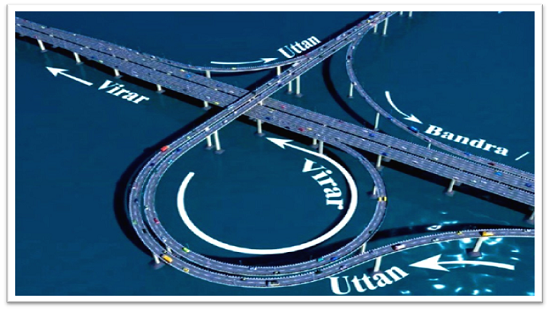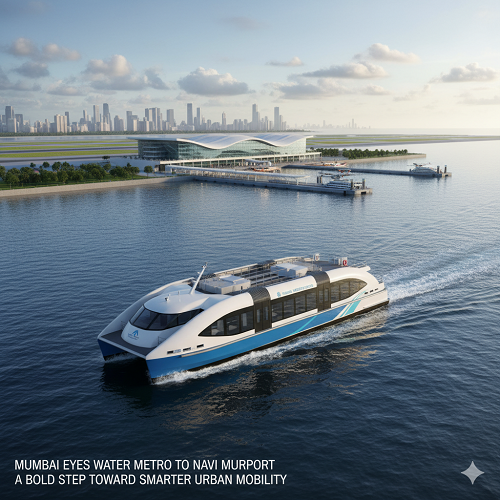
Maharashtra’s 70,000-Crore Push for Seamless Travel, Cabinet Approves 55-km Uttan–Virar Sea Link to Transform Mumbai’s Connectivity
Mumbai’s infrastructure story has entered a defining new phase. In a significant move that could reshape regional connectivity and ease urban congestion, the Maharashtra cabinet’s infrastructure committee, chaired by Chief Minister Devendra Fadnavis, has approved the ambitious 55.12-km Uttan, Virar Sea Link extension to Vadhavan Port.
This decision, part of a broader mobility vision for the Mumbai Metropolitan Region (MMR), also includes green signals for the 66-km Nashik Inner Ring Road project and key Pune Metro upgrades. Together, these initiatives mark a renewed commitment to reducing travel time, supporting economic expansion, and building infrastructure ready for the next decade.
A New Artery for Mumbai’s Growth
The Uttan, Virar Sea Link project represents more than another coastal bridge, it is a strategic lifeline for Mumbai’s northern growth corridor. The 24.35-km main bridge, with feeder and connector roads, will form the northern extension of the ongoing Mumbai Coastal Road and the Versova, Virar Sea Link, effectively linking the city’s southern and northern tips with uninterrupted coastal mobility.
Once complete, the project is expected to cut travel time between South Mumbai and Virar by nearly 60%, diverting heavy traffic away from the Western Express Highway and easing congestion in densely populated suburbs. By connecting to the proposed Vadhavan Port, one of India’s upcoming mega ports, the sea link will also enhance logistics efficiency, positioning Mumbai as a high-capacity trade and transport hub.
According to preliminary estimates by state planners, the Uttan, Virar Sea Link could handle over 1.2 lakh vehicles per day upon completion, bringing measurable economic and environmental relief by decongesting arterial roads and lowering vehicular emissions.
Infrastructure as Policy, Not Politics
The infrastructure committee’s decisions under CM Fadnavis have shown a consistent pattern, focus on long-term mobility over short-term optics. The cabinet’s latest clearance reflects an integrated transport strategy that connects urban, regional, and industrial centers through smart infrastructure.
Deputy Chief Ministers Eknath Shinde and Ajit Pawar, both members of the committee, underscored the urgency of seamless connectivity between emerging growth zones. The Uttan, Virar Sea Link, Nashik’s new inner ring road, and Pune’s Metro expansion form three parts of one vision, decentralized development backed by infrastructure depth.
Nashik’s Kumbh-Ready Upgrade
The cabinet also cleared a 66-km inner ring road for Nashik, a city poised to host the next Kumbh Mela. The project’s design focuses on reducing pilgrimage-time congestion and improving year-round city logistics. Land acquisition approvals have been expedited, and officials aim to complete core phases before the Mela’s preparatory cycle begins.
The ring road will not only serve as a festival management asset but also as a long-term urban mobility solution, opening new residential and commercial corridors around the city’s periphery. With Nashik emerging as a secondary growth node in Maharashtra’s economic map, this project aligns spiritual tourism with smart city planning.
Pune Metro’s Modernization Leap
In Pune, Chief Minister Fadnavis directed immediate upgrades to the Pune Metro, including the transition to six-coach trains to meet rising ridership demand. The state also approved acceleration of new corridors, particularly the planned tunnel connectivity to the proposed Purandar International Airport.
Complementary measures like multi-level parking and last-mile connectivity systems are also being fast-tracked to transform Pune’s Metro into a fully integrated urban transport ecosystem. The expansion aligns with the broader vision of creating a “Tri-City Mobility Triangle,” connecting Mumbai, Pune, and Nashik with multimodal transport systems that synchronize road, rail, and metro networks.
Building the Next Decade of Connectivity
The Fadnavis-led infrastructure roadmap builds on the principle that urban mobility is not just about reducing commute time, it’s about enabling economic speed. By linking coastal bridges, ring roads, and metro systems, Maharashtra is constructing a mobility web that supports ports, airports, and industrial corridors in one unified design.
The combined length of the projects approved, over 120 km of high-capacity infrastructure, will serve as the foundation for Maharashtra’s next phase of growth. Planners estimate that these investments could generate over 1.5 lakh direct and indirect jobs, boost logistics efficiency by 25%, and contribute significantly to the state’s GDP through reduced transport bottlenecks.
Toward a Smarter, Faster Maharashtra
This round of cabinet approvals reflects a maturing infrastructure strategy, one that balances vision with execution. The Uttan, Virar Sea Link will extend Mumbai’s development northward, Nashik’s ring road will bring order to expanding pilgrim and freight traffic, and Pune’s Metro upgrades will modernize one of India’s fastest-growing urban centers.
Together, they represent a clear policy message, Maharashtra’s future growth will rest on the speed, scale, and sustainability of its infrastructure. With the Fadnavis-led committee’s proactive approach, the state is signaling its readiness for a new era of connected, competitive, and future-ready cities.
The Road to a Connected Tomorrow
Maharashtra’s latest infrastructure approvals are not isolated projects, they are the building blocks of a new economic geography. From the Arabian Sea to the Deccan Plateau, the state is engineering an interconnected ecosystem that will redefine how people and goods move.
The Uttan, Virar Sea Link, Nashik Ring Road, and Pune Metro expansions together illustrate what modern governance can achieve when vision meets velocity. In doing so, Maharashtra is not just expanding roads and bridges, it is building pathways to prosperity, positioning itself as India’s blueprint for integrated, future-forward infrastructure.





